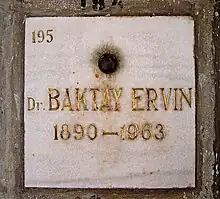Ervin Baktay | |
|---|---|
| Born | Ervin Gottesmann 1890 |
| Died | 1963 |
| Occupation | Writer |
| Relatives | Amrita Sher-Gil (niece) |
Ervin Baktay (1890–1963; born Ervin Gottesmann[1]) was an author noted for popularizing Indian culture in Hungary.[2][3]

Dr. Ervin Baktay's tomb at Farkasréti Cemetery
He had started his career as a painter[4] and he encouraged his niece Amrita Sher-Gil to pursue art.[5] Baktay gave up painting to study eastern religions and art, and became a renowned Indologist.[4]
Family
Ervin Baktay was uncle to artist Amrita Sher-Gil and nephew to Nagybánya artist Alfréd Gottesmann (1872–1965).
Works
He translated the Kama Sutra in 1920 and then published a version of the Mahābhārata in 1923.[6] In 1960, he produced a version of the Ramayana.[6]
Selected publications
- Baktay Ervin: Die Kunst Indiens; Übers. Edith Róth; Bearb. Heinz Kucharski; Berlin - Budapest, Terra - Akad. Verlag, 1963.
References
- ↑ Baktay Ervin (1890-1963) megjelent könyvei (Terebess Ázsia E-Tár)
- ↑ Indo-Hungarian Cultural & Educational Relations, Historical Perspective Archived 2008-10-09 at the Wayback Machine, Indian Embassy in Hungary
- ↑ Claudine Bautze-Picron. Ervin Baktay, the art historian. BÉLA KELÉNYI, Az indológus indián. Baktay Ervin emlékezete (The Indologist Indian: Memory of Ervin Baktay), Budapest: Museum of Fine Arts – Ferenc Hopp Museum of Eastern Asiatic Arts, 2014 (pp. 364-9)., 2014. halshs-01079408
- 1 2 Amrita Shergil, sikh-heritage.co.uk
- ↑ "Amrita Sher-Gil - 100 People Who Shaped India". Archived from the original on 2007-07-01. Retrieved 2009-02-11.
- 1 2 Pollet, Ag (1995). "II. International impact of Ramayana". Indian Epic Values: Rāmāyaṇa and Its Impact : Proceedings of the 8th International Rāmāyaṇa Conference, Leuven, 6-8 July 1991. Leuven: Peeters Publishers. p. 149. ISBN 90-6831-701-6.
This article is issued from Wikipedia. The text is licensed under Creative Commons - Attribution - Sharealike. Additional terms may apply for the media files.